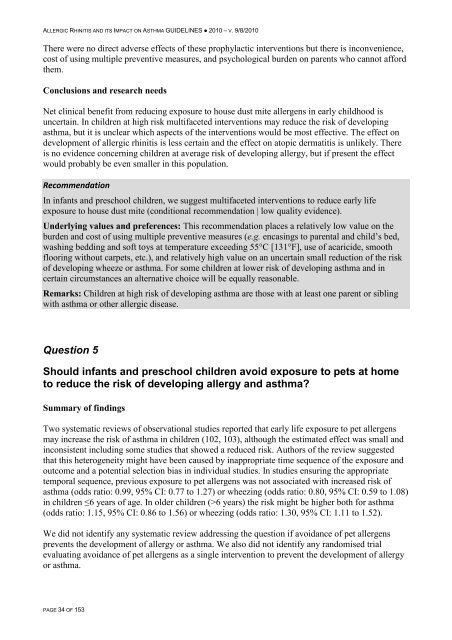Allergic Rhinitis and its Impact on Asthma - ARIA
Allergic Rhinitis and its Impact on Asthma - ARIA
Allergic Rhinitis and its Impact on Asthma - ARIA
Create successful ePaper yourself
Turn your PDF publications into a flip-book with our unique Google optimized e-Paper software.
ALLERGIC RHINITIS AND ITS IMPACT ON ASTHMA GUIDELINES ● 2010 – V. 9/8/2010<br />
There were no direct adverse effects of these prophylactic interventi<strong>on</strong>s but there is inc<strong>on</strong>venience,<br />
cost of using multiple preventive measures, <str<strong>on</strong>g>and</str<strong>on</strong>g> psychological burden <strong>on</strong> parents who cannot afford<br />
them.<br />
C<strong>on</strong>clusi<strong>on</strong>s <str<strong>on</strong>g>and</str<strong>on</strong>g> research needs<br />
Net clinical benefit from reducing exposure to house dust mite allergens in early childhood is<br />
uncertain. In children at high risk multifaceted interventi<strong>on</strong>s may reduce the risk of developing<br />
asthma, but it is unclear which aspects of the interventi<strong>on</strong>s would be most effective. The effect <strong>on</strong><br />
development of allergic rhinitis is less certain <str<strong>on</strong>g>and</str<strong>on</strong>g> the effect <strong>on</strong> atopic dermatitis is unlikely. There<br />
is no evidence c<strong>on</strong>cerning children at average risk of developing allergy, but if present the effect<br />
would probably be even smaller in this populati<strong>on</strong>.<br />
Recommendati<strong>on</strong><br />
In infants <str<strong>on</strong>g>and</str<strong>on</strong>g> preschool children, we suggest multifaceted interventi<strong>on</strong>s to reduce early life<br />
exposure to house dust mite (c<strong>on</strong>diti<strong>on</strong>al recommendati<strong>on</strong> | low quality evidence).<br />
Underlying values <str<strong>on</strong>g>and</str<strong>on</strong>g> preferences: This recommendati<strong>on</strong> places a relatively low value <strong>on</strong> the<br />
burden <str<strong>on</strong>g>and</str<strong>on</strong>g> cost of using multiple preventive measures (e.g. encasings to parental <str<strong>on</strong>g>and</str<strong>on</strong>g> child’s bed,<br />
washing bedding <str<strong>on</strong>g>and</str<strong>on</strong>g> soft toys at temperature exceeding 55°C [131°F], use of acaricide, smooth<br />
flooring without carpets, etc.), <str<strong>on</strong>g>and</str<strong>on</strong>g> relatively high value <strong>on</strong> an uncertain small reducti<strong>on</strong> of the risk<br />
of developing wheeze or asthma. For some children at lower risk of developing asthma <str<strong>on</strong>g>and</str<strong>on</strong>g> in<br />
certain circumstances an alternative choice will be equally reas<strong>on</strong>able.<br />
Remarks: Children at high risk of developing asthma are those with at least <strong>on</strong>e parent or sibling<br />
with asthma or other allergic disease.<br />
Questi<strong>on</strong> 5<br />
Should infants <str<strong>on</strong>g>and</str<strong>on</strong>g> preschool children avoid exposure to pets at home<br />
to reduce the risk of developing allergy <str<strong>on</strong>g>and</str<strong>on</strong>g> asthma?<br />
Summary of findings<br />
Two systematic reviews of observati<strong>on</strong>al studies reported that early life exposure to pet allergens<br />
may increase the risk of asthma in children (102, 103), although the estimated effect was small <str<strong>on</strong>g>and</str<strong>on</strong>g><br />
inc<strong>on</strong>sistent including some studies that showed a reduced risk. Authors of the review suggested<br />
that this heterogeneity might have been caused by inappropriate time sequence of the exposure <str<strong>on</strong>g>and</str<strong>on</strong>g><br />
outcome <str<strong>on</strong>g>and</str<strong>on</strong>g> a potential selecti<strong>on</strong> bias in individual studies. In studies ensuring the appropriate<br />
temporal sequence, previous exposure to pet allergens was not associated with increased risk of<br />
asthma (odds ratio: 0.99, 95% CI: 0.77 to 1.27) or wheezing (odds ratio: 0.80, 95% CI: 0.59 to 1.08)<br />
in children ≤6 years of age. In older children (>6 years) the risk might be higher both for asthma<br />
(odds ratio: 1.15, 95% CI: 0.86 to 1.56) or wheezing (odds ratio: 1.30, 95% CI: 1.11 to 1.52).<br />
We did not identify any systematic review addressing the questi<strong>on</strong> if avoidance of pet allergens<br />
prevents the development of allergy or asthma. We also did not identify any r<str<strong>on</strong>g>and</str<strong>on</strong>g>omised trial<br />
evaluating avoidance of pet allergens as a single interventi<strong>on</strong> to prevent the development of allergy<br />
or asthma.<br />
PAGE 34 OF 153


